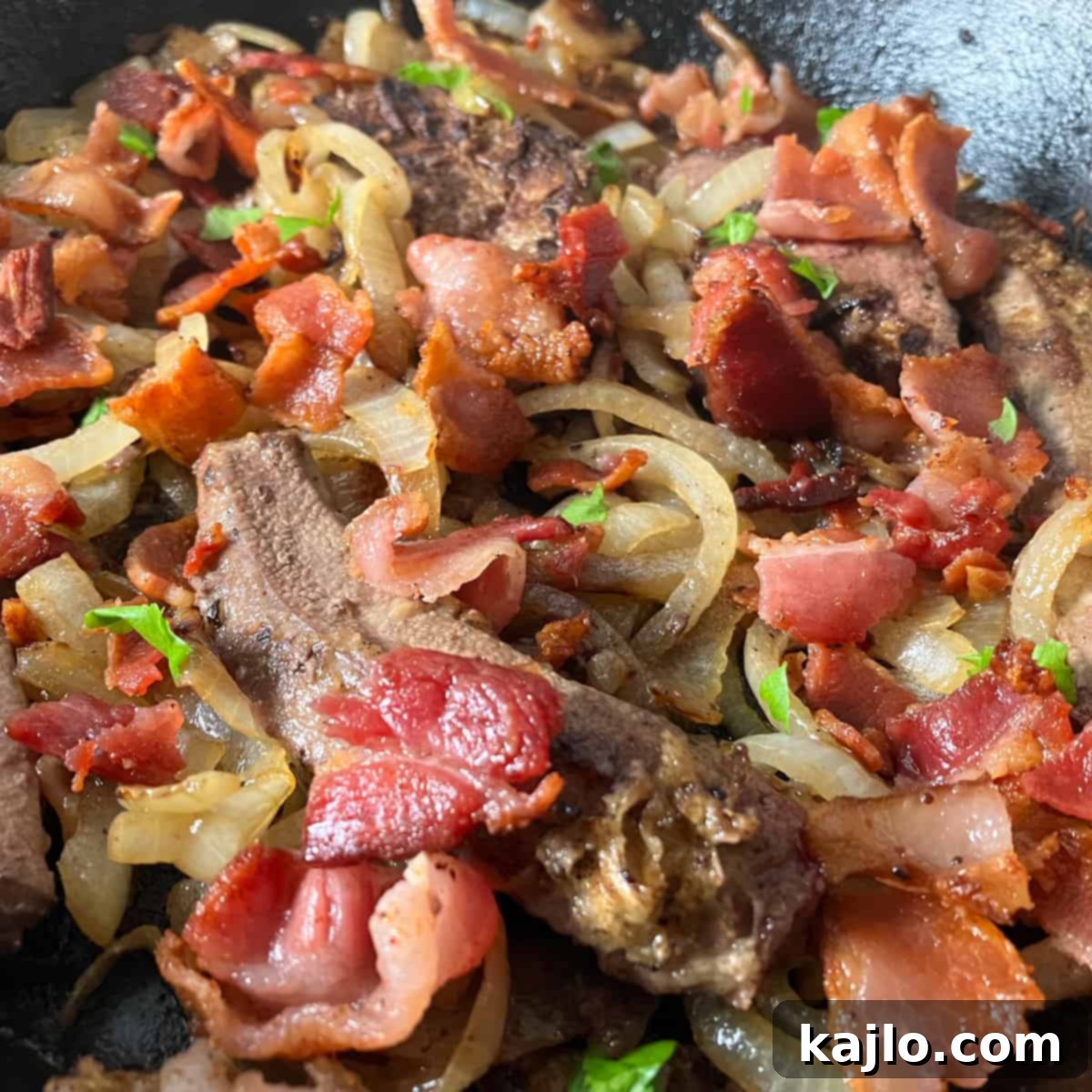Mastering Pork Liver: Delicious Recipes, Nutritional Benefits, and Expert Tips
Discover the rich flavor and incredible nutritional value of pork liver! Often overlooked, cooking pork liver is surprisingly straightforward and yields dishes that many find even more delicious than beef liver. This comprehensive guide will walk you through preparing two fantastic pork liver recipes: a classic pan-fried pork liver with onions and bacon, and a sophisticated, creamy pork liver pâté. Beyond the kitchen, we’ll delve into the remarkable benefits of incorporating pork liver into your diet, advise on where to purchase high-quality pork liver, and address common questions to make you a confident pork liver enthusiast.

“Does a pig have a liver?” While perhaps not a frequent thought, the answer is a resounding yes, and it’s a culinary gem! If you’re a fan of liverwurst, a popular pork liver sausage, you’re going to adore these versatile and flavorful recipes. Get ready to transform this nutrient-dense organ meat into truly satisfying meals.
Sourcing Quality Pork Liver for Your Kitchen
Finding fresh, high-quality pork liver can sometimes be a challenge at conventional supermarkets. While large retailers like Walmart and Amazon typically don’t stock fresh pork liver, dedicated online suppliers offer excellent options. For those seeking premium, pasture-raised pork liver, consider exploring online sources such as US Wellness Meats or White Oak Pastures. These platforms often provide products from ethically raised animals, ensuring both quality and flavor.
Alternatively, if you prefer to buy locally, check your community’s farmer’s markets. Many small-scale farmers who prioritize sustainable practices may offer organic pork liver. Ethnic butchers, particularly Polish butchers, are also excellent resources, as liver is a staple in many traditional cuisines. Don’t hesitate to ask your local butcher if they can special-order it for you if it’s not readily available.
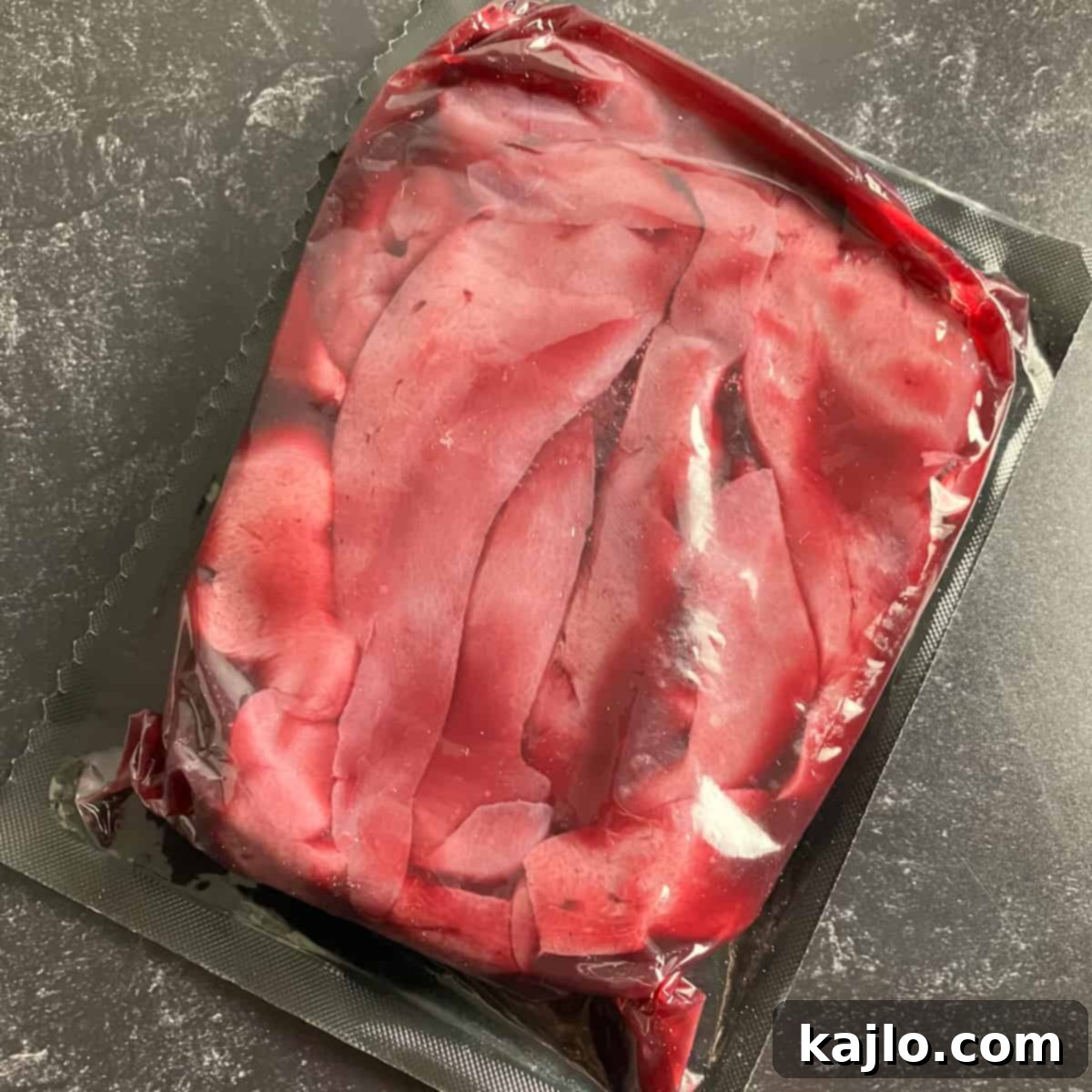
Versatile Ways to Cook Pork Liver
Pork liver is incredibly versatile and can be prepared in numerous ways, including grilling, sautéing, or transforming it into a rich pâté. If you tend to find the robust, strong flavor of certain livers (like pork or goose liver) a bit intense, preparing pâté is an excellent strategy. The blending with other ingredients, particularly fats and aromatics, mellows the flavor while retaining its nutritional punch.
Below, we provide two distinct recipe options, each requiring only ½ lb (227 grams) of pork liver. This makes them perfect for smaller servings or for trying out both preparations without over-committing. Let’s gather your ingredients for these delicious pig liver creations:
Ingredients for Pork Liver Pâté (adapted from Weston Price):
- 8 ounces (227 grams) pork liver
- 6 cloves garlic, minced
- ⅓ cup bacon fat (or other pork fat/lard)
- 5 pieces thick-sliced bacon
- 1 medium onion, chopped
- 3 sprigs fresh parsley
- 2 sprigs fresh basil
- ¼ cup red wine
- Pinch of salt
- 1-2 cups buttermilk (for soaking pork liver)
Ingredients for Pan-Fried Pork Liver, Onions, and Bacon:
- 8 ounces (227 grams) pork liver
- 2 tablespoons bacon fat (or other pork fat)
- 4 pieces thick-sliced bacon
- 2 medium onions, halved and sliced thinly
- 1½ tablespoons flour
- Salt and pepper, to taste
- 1-2 cups buttermilk (for soaking pork liver)
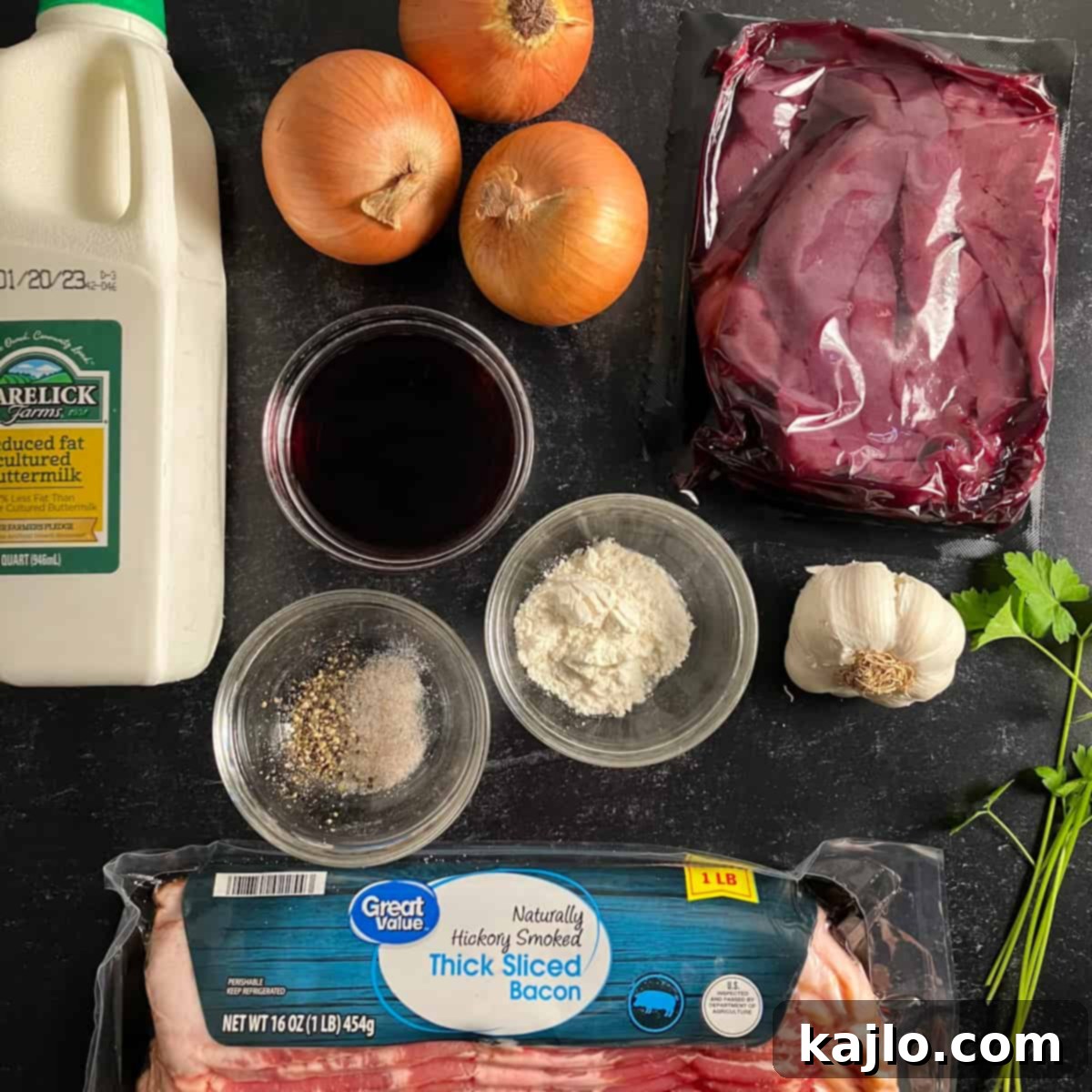
Why Soak Liver in Milk Before Cooking?
Soaking liver in milk or buttermilk is a time-honored technique used to draw out any strong, sometimes metallic flavors and odors that can be present in organ meats. Beyond flavor refinement, buttermilk’s acidity also acts as a natural tenderizer, resulting in a more palatable and softer texture, especially for pan-fried preparations.
Step-by-Step Pork Liver Recipes
Now, let’s dive into the detailed instructions for crafting these delightful pork liver dishes.
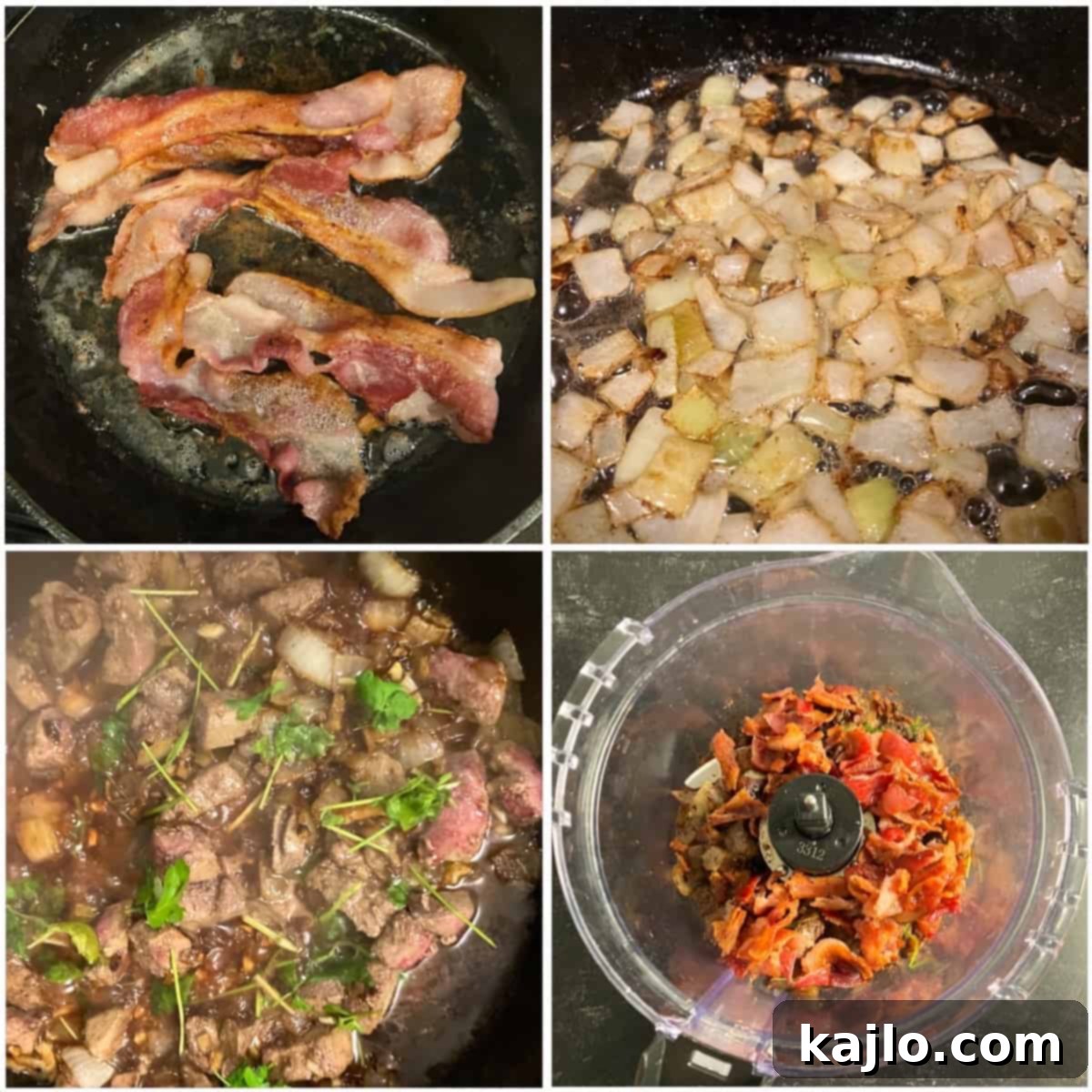
Pork Liver Pâté Instructions:
Carefully remove any visible membrane from the pork liver (your butcher may have already done this). Chop the liver into manageable pieces. Place them in a medium bowl and cover completely with buttermilk. Refrigerate and allow to soak for a minimum of 2 hours. Once soaked, drain the liver and pat the pieces thoroughly dry with clean paper towels. This crucial step helps reduce strong flavors and tenderizes the liver.
In a sturdy cast-iron skillet, cook the thick-sliced bacon over medium heat until crispy. Remove the cooked bacon from the pan and set it aside to cool, reserving about ⅓ cup of the rendered bacon grease in the skillet. Crumble the cooled bacon once it’s firm enough.
Add the chopped onion to the skillet with the reserved bacon fat. Sauté for approximately 5 minutes until softened and translucent. Next, add the prepared pork liver pieces and minced garlic to the skillet, cooking for an additional 5-10 minutes. Ensure the liver is lightly browned on all sides but not overcooked.
Stir in the fresh parsley, basil, red wine, and a pinch of salt. Reduce the heat to low, cover the skillet, and allow the mixture to simmer gently for about 5 minutes, allowing the flavors to meld beautifully.
Remove the skillet from the heat and let the liver mixture cool slightly. Transfer the contents of the skillet, along with the crumbled cooked bacon, to a food processor. Process until the mixture is completely smooth and creamy. Taste and adjust seasoning if necessary.
Serve the luxurious pork liver pâté chilled or at room temperature. It pairs wonderfully with crusty crostini, artisanal crackers, or fresh bread. For best results, allow the pâté to chill in the refrigerator for at least an hour before serving to firm up and allow flavors to deepen.
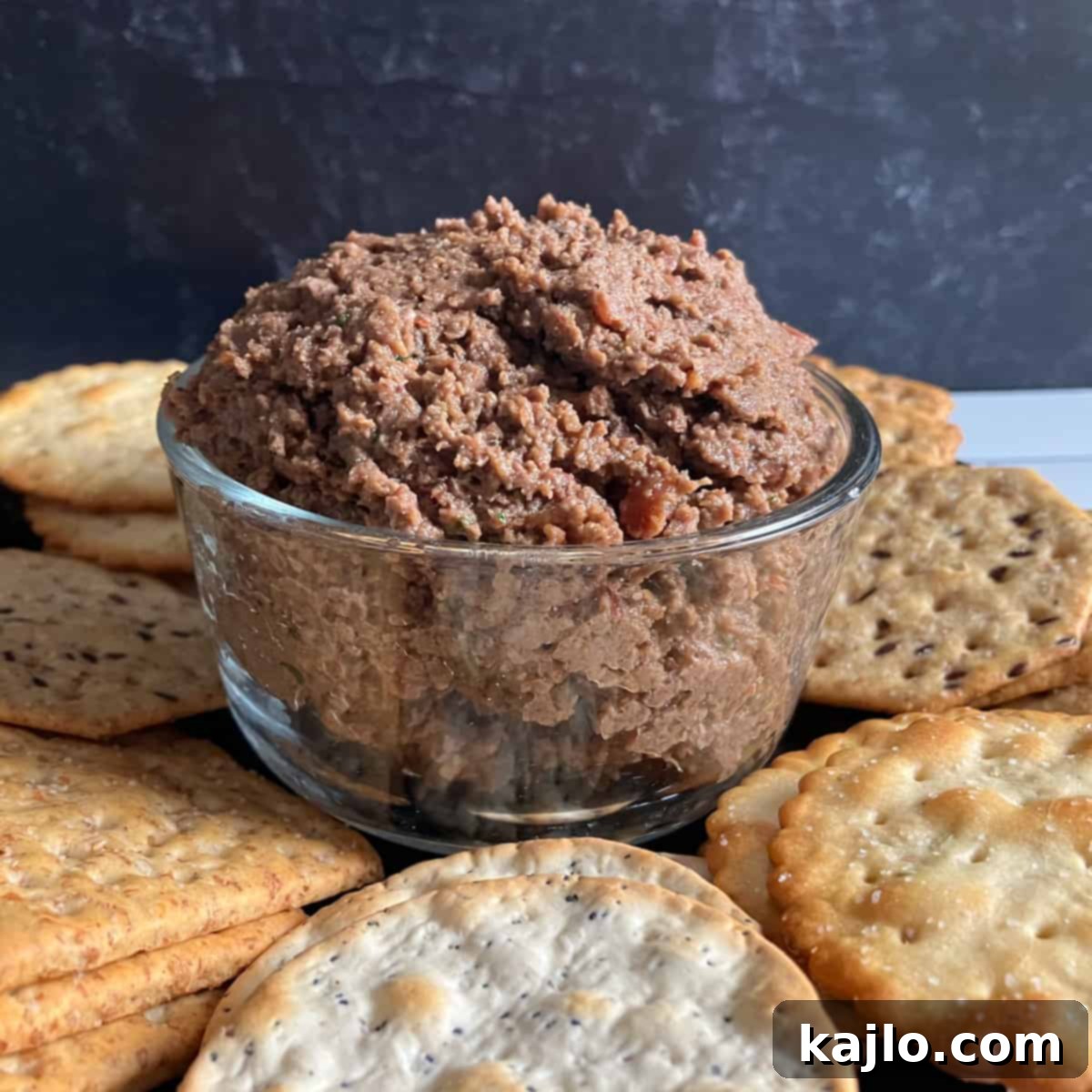
Pork Liver and Onions with Bacon Recipe Instructions:
This classic preparation highlights the natural flavor of pork liver, complemented by sweet caramelized onions and savory bacon.
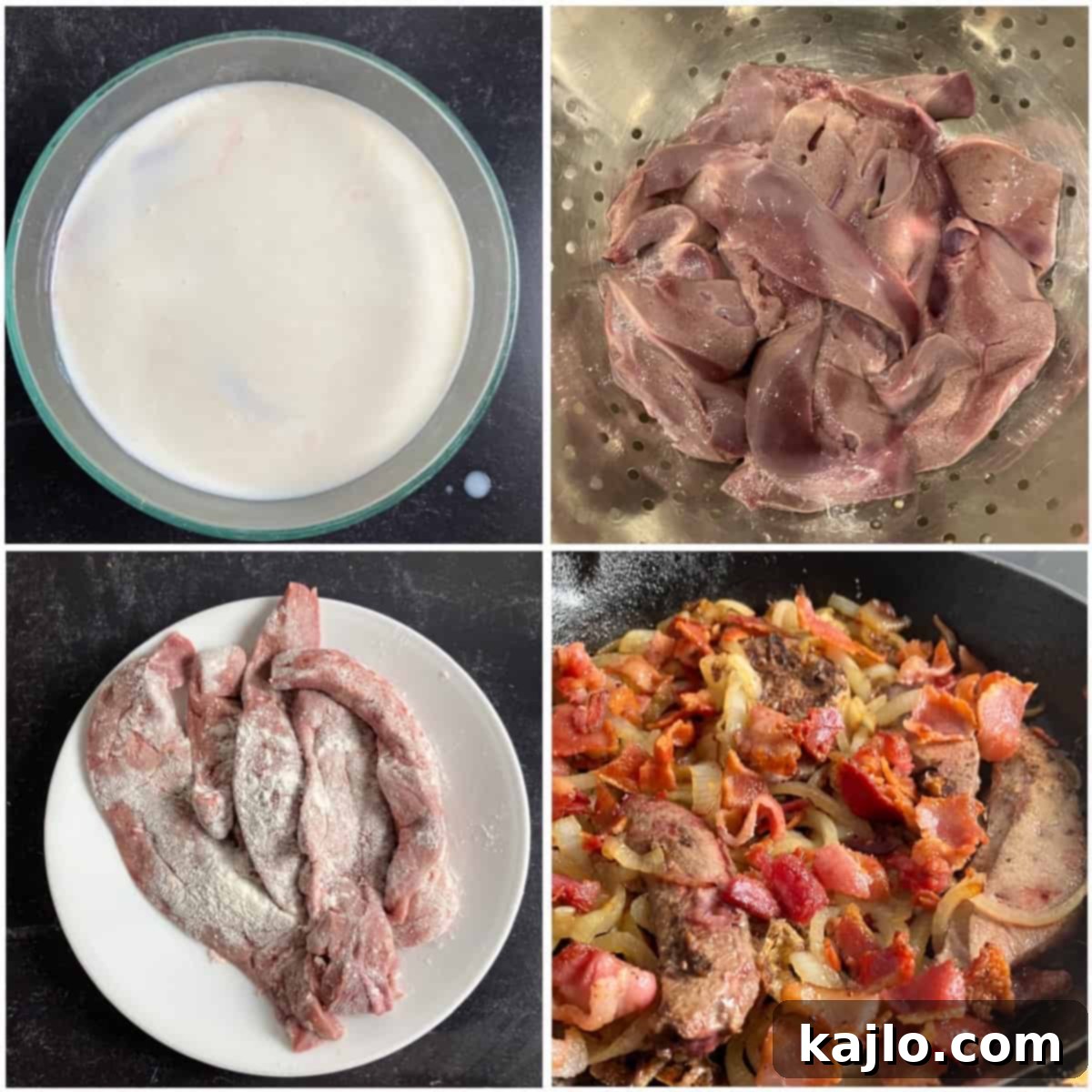
As with the pâté, remove any membranes from the pork liver and slice it into thin pieces, about ⅛-¼ inch thick. Place the slices in a medium bowl, cover with buttermilk, and refrigerate for 2 hours to soak. After soaking, thoroughly pat the liver slices dry with paper towels. This step is key for tenderness and flavor.
Cook the thick-sliced bacon in a large skillet over medium heat until it’s perfectly crisp. Remove the bacon and set it aside to cool, reserving all the rendered bacon grease in the pan. Crumble the bacon once cooled.
Add the thinly sliced onions to the skillet with the bacon fat. Sauté over medium heat until they are deeply caramelized and tender, approximately 8-10 minutes. Once cooked to your preference, remove the onions from the pan, leaving about 2 tablespoons of bacon fat behind in the skillet.
Lightly dredge each pork liver slice in flour, shaking off any excess. Place the floured liver slices into the hot skillet with the remaining bacon fat. Cook for a brief 1-3 minutes per side. Pork liver cooks quickly; ensure it reaches a minimum internal temperature of 145°F (63°C) using a meat thermometer. Season generously with salt and pepper to taste immediately after cooking.
Once the liver is cooked through, return the caramelized onions and crumbled bacon to the pan. Toss gently to combine and heat briefly. Serve immediately for the best flavor and texture.
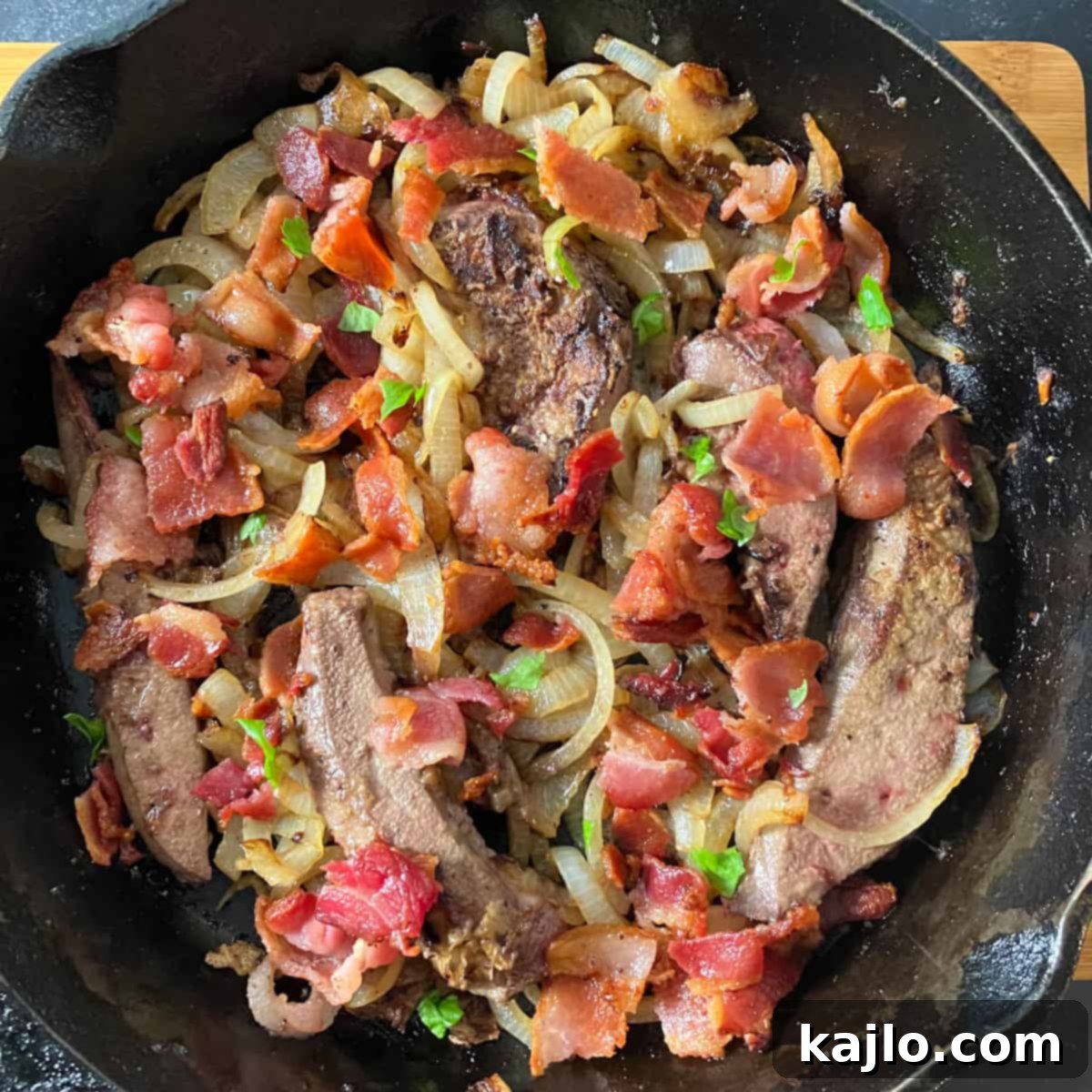
How Long to Cook Pork Liver?
Thinly sliced pork liver cooks remarkably fast, requiring only 1-3 minutes per side over medium heat on the stovetop. It can also be braised for longer periods for a fork-tender result, but care must be taken not to overcook it, as it can become tough. Always use a meat thermometer to ensure it reaches a safe internal temperature of 145°F (63°C).
Complementing Pig Liver: Perfect Pairings
Wondering what to serve alongside your flavorful pork liver dishes? Pork liver pairs beautifully with a variety of carbohydrate-rich sides that can balance its rich taste. Classic choices include creamy mashed potatoes, sweet corn, fluffy rice, or traditional pierogi. Here are some additional side dish ideas to inspire your meal planning:
- Fresh or steamed vegetables (e.g., green beans, carrots)
- Roasted or air-fried frozen vegetables for a quick and easy option
- Cauliflower rice, if you’re looking for a low-carb alternative
- Keto crackers or other low-carb bread options to accompany pâté
- Crispy air fryer toast or garlic bread to mop up delicious pan juices
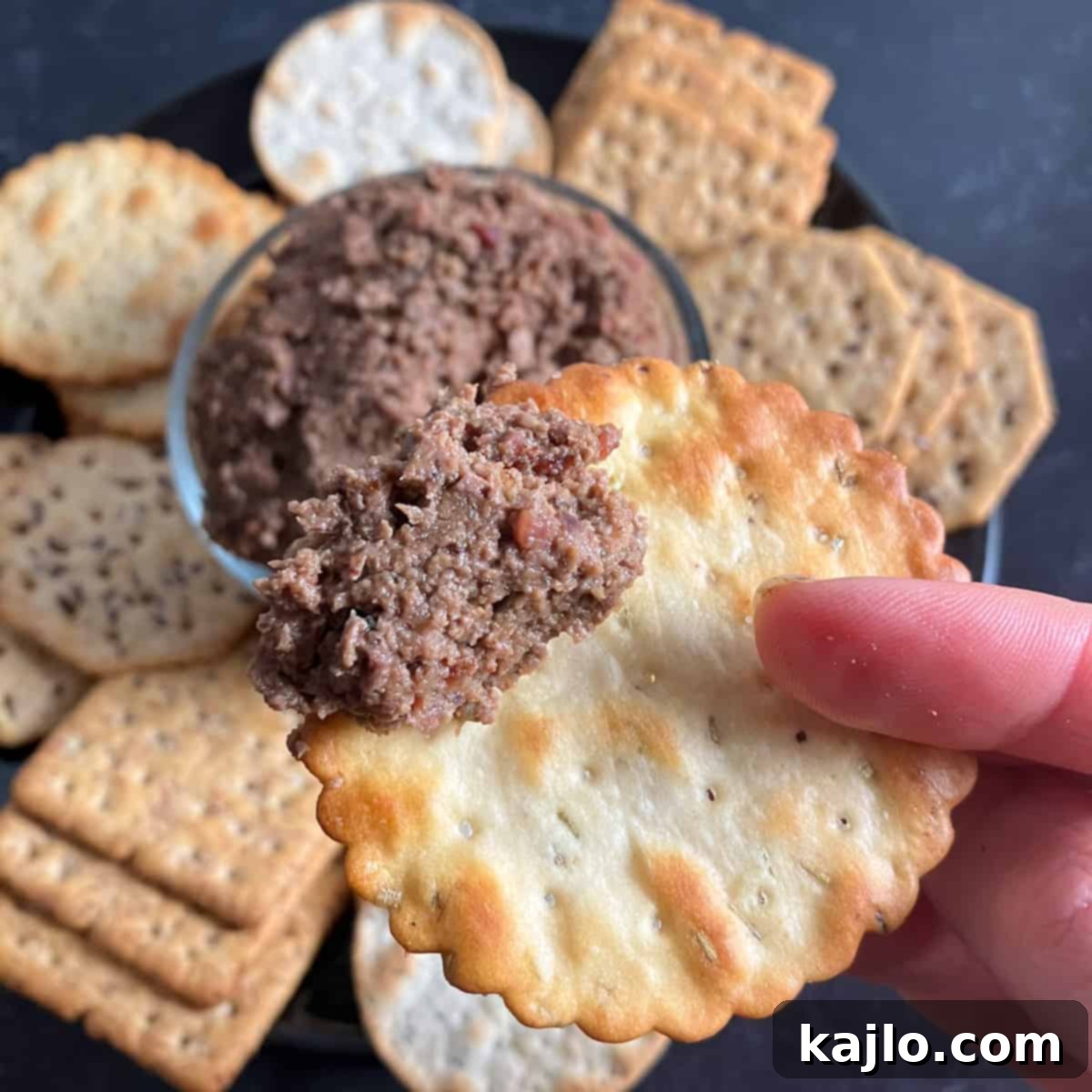
Pork Liver: A Nutritional Powerhouse
What are the remarkable benefits of eating pork liver? Liver, across various animal sources, is frequently hailed as a superfood due to its exceptional nutrient density. It’s truly like nature’s multivitamin! Here’s a breakdown of the nutritional information for cooked pork liver (per 3 ounces or 85 grams, based on Cronometer data):
- Calories: 140
- Carbs: 3.2 grams
- Fiber: 0 grams
- Fat: 3.7 grams
- Saturated Fat: 1.2 grams
- Cholesterol: 301.75 mg
- Protein: 22.12 grams
- Thiamin (B1): 14.6% Daily Value (DV)
- Riboflavin (B2): 109.8% DV
- Niacin (B3): 35.8% DV
- Vitamin B5 (Pantothenic Acid): 40.6% DV
- Vitamin B6: 24.2% DV
- Vitamin B12: 264.5% DV
- Folate (B9): 34.6% DV
- Vitamin A (Retinol): 304.6% DV (4594.25 µg retinol)
- Vitamin C: 33.4% DV
- Calcium: 0.9% DV
- Iron: 84.6% DV
- Phosphorus: 20.5% DV
- Potassium: 3.6% DV
- Selenium: 82% DV
- Sodium: 42 mg
- Zinc: 38.1% DV
As you can see, pork liver is an exceptional source of riboflavin, niacin, vitamin B5, vitamin B6, vitamin B12, folate, vitamin A, vitamin C, iron, phosphorus, selenium, and zinc. It’s also a good source of thiamin. This impressive profile makes it a natural, whole-food alternative to many synthetic multivitamin supplements, especially for its rich B-complex vitamin content.
Depending on the specific recipe and added ingredients, pig liver is naturally a keto-friendly, low-carb, and gluten-free food, making it suitable for a variety of dietary needs. Detailed nutrition information for our specific pork liver recipes can be found in the recipe card below.
Comparing Liver Types: Pork vs. Beef vs. Chicken
To help you decide which liver best suits your dietary goals, here’s a quick nutritional comparison of a 3-ounce (85g) cooked portion of pork liver, beef liver, and chicken liver:
| Nutrient | Pork Liver | Beef Liver | Chicken Liver |
|---|---|---|---|
| Calories | 140 | 162 | 146 |
| Carbohydrates (g) | 3.2 | 4.4 | 0.3 |
| Fiber (g) | 0 | 0 | 0 |
| Total Fat (g) | 3.7 | 4.5 | 5.5 |
| Saturated Fat (g) | 1.2 | 2.5 | 1.7 |
| Cholesterol (mg) | 301.75 | 336.79 | 479.4 |
| Protein (g) | 22.12 | 24.73 | 21.91 |
| Thiamin (% DV) | 14.6 | 11 | 16.5 |
| Riboflavin (% DV) | 109.8 | 171.3 | 115.7 |
| Niacin (% DV) | 35.8 | 74.5 | 59.2 |
| Vitamin B5 (% DV) | 40.6 | 60.5 | 70.7 |
| Vitamin B6 (% DV) | 24.2 | 43.2 | 35.7 |
| Vitamin B12 (% DV) | 264.5 | 1000.5 | 299.3 |
| Folate (% DV) | 34.6 | 53.8 | 119 |
| Vitamin A (% DV) | 304.6 | 535.4 | 243.4 |
| Vitamin C (% DV) | 33.4 | 2.7 | 3.8 |
| Iron (% DV) | 84.6 | 30.9 | 60.8 |
| Phosphorus (% DV) | 20.5 | 42.3 | 37.6 |
| Zinc (% DV) | 38.1 | 30.1 | 22.7 |
The “healthiest” liver ultimately depends on your individual nutritional needs and preferences. From this comparison, pork liver stands out for being lowest in calories and highest in vitamin C, iron, and zinc. Beef liver, on the other hand, is particularly rich in riboflavin, vitamin B12, vitamin A, and phosphorus. Interestingly, chicken liver, while also very nutritious, appears to have the highest cholesterol content in this comparison. For a well-rounded nutrient intake, consider rotating different types of liver in your diet.
Pork Liver vs. Beef Liver: A Taste and Nutrition Debate
From a purely subjective standpoint, many find that pork liver boasts a milder, more palatable flavor profile compared to beef liver, making it an excellent entry point for those new to organ meats. In terms of nutritional advantages, both pork and beef liver offer unique benefits. Opt for pork liver if you’re looking for higher amounts of vitamin C and iron. However, if your goal is to boost intake of vitamin B12 and vitamin A, beef liver would be the superior choice. The “better” choice truly comes down to personal taste preference and specific dietary requirements.

Is Pork Liver High in Cholesterol?
Yes, pork liver, much like other types of liver, is considered a high-cholesterol food. However, it’s important to remember that for most healthy individuals, dietary saturated fat typically has a more significant impact on blood cholesterol levels than dietary cholesterol itself. Fortunately, pork liver is relatively low in saturated fat, containing only about 1.2 grams per 3-ounce cooked serving. Therefore, moderate consumption can fit into a balanced diet without excessive concern for cholesterol levels.
Is Pork Liver Good for Diabetics?
Pork liver can be a suitable addition to a balanced diet for individuals with diabetes. Its low carbohydrate content makes it an easy fit for both carb exchange plans and general low-carb dietary approaches. When enjoyed as part of a varied diet that includes other food groups and adheres to portion control, pork liver can contribute valuable nutrients without significantly impacting blood sugar levels.
Pork Liver and Pregnancy: Navigating Vitamin A Intake
Organizations like the NHS often advise pregnant women to avoid liver and liver pâté due to the risk of vitamin A overdose, which can be harmful to a developing fetus. However, it is possible to consume very small, carefully controlled amounts of liver and maintain a healthy vitamin A intake. The key is moderation and strict adherence to recommended guidelines.
Pork liver is indeed an extremely nutrient-dense food, and most of its abundant vitamins are water-soluble, meaning any excess is easily excreted by the body. Vitamin A (retinol) in liver is the exception; it’s a fat-soluble vitamin that can accumulate and become toxic in high doses. The tolerable upper intake level for preformed vitamin A (retinol) for adults, including pregnant women, is 3000 mcg per day. Given that a 3-ounce cooked portion of pork liver contains approximately 4600 mcg of vitamin A, this means that no more than roughly 2 ounces of cooked pork liver should be consumed daily, and only if no other significant sources of retinol are eaten.
To prioritize safety, it’s generally recommended to avoid daily consumption of liver and to keep individual portions to 1 ounce or less, especially during pregnancy. Consuming too much vitamin A can have teratogenic effects on the unborn baby, a risk that is simply not worth taking. Always consult with your physician or a registered dietitian who is familiar with your medical history and pregnancy needs before making significant dietary changes, especially when it comes to nutrient-dense foods like liver.
Does Pork Liver Have Iron?
Absolutely! Pork liver is an exceptional source of iron, providing an impressive 84.6% of the Daily Value (DV) per 3-ounce cooked portion. This makes it an excellent food choice for those looking to boost their iron intake, particularly individuals prone to iron deficiency or anemia.
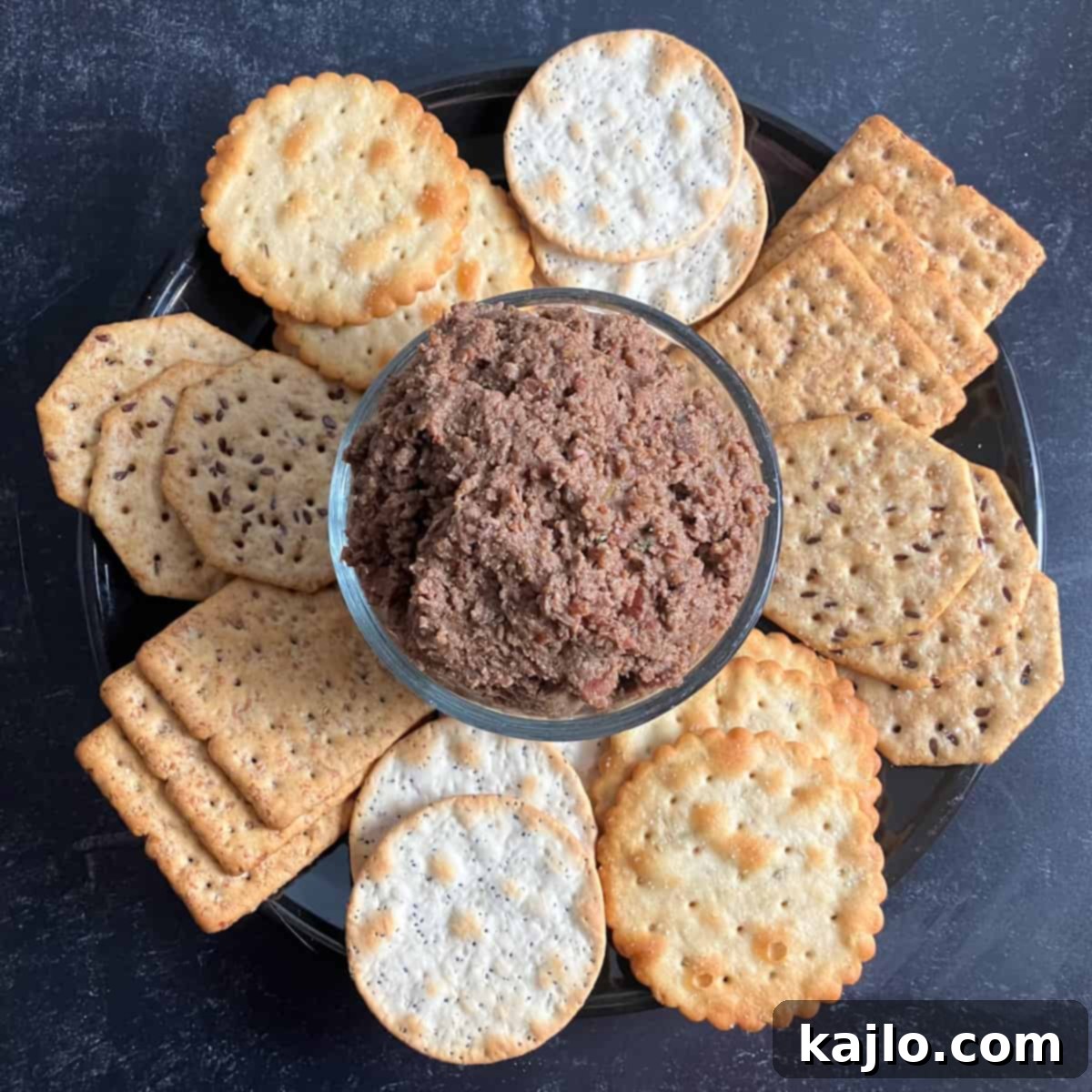
Does Pork Liver Have Protein?
Yes, pork liver is an outstanding source of high-quality protein. A 3-ounce cooked portion contains approximately 22 grams of protein, making it an excellent component of a protein-rich diet for muscle maintenance, growth, and overall satiety.
Storing Pork Liver: Fresh and Cooked
Proper storage is crucial for maintaining the quality and safety of pork liver. You can safely store raw pork liver in the freezer for several months. For cooked pork liver, preparing it as a pâté is the ideal method for freezing. You can freeze small portions of pâté in ice cube trays, then transfer the frozen cubes to an airtight container or freezer bag, ensuring they are well-covered to prevent freezer burn. This allows for convenient portion control and extended storage.
The pan-fried pork liver and onions recipe, however, does not freeze as well. The texture of the liver and onions can become less appealing after freezing and reheating. For best quality, this dish is best enjoyed fresh.
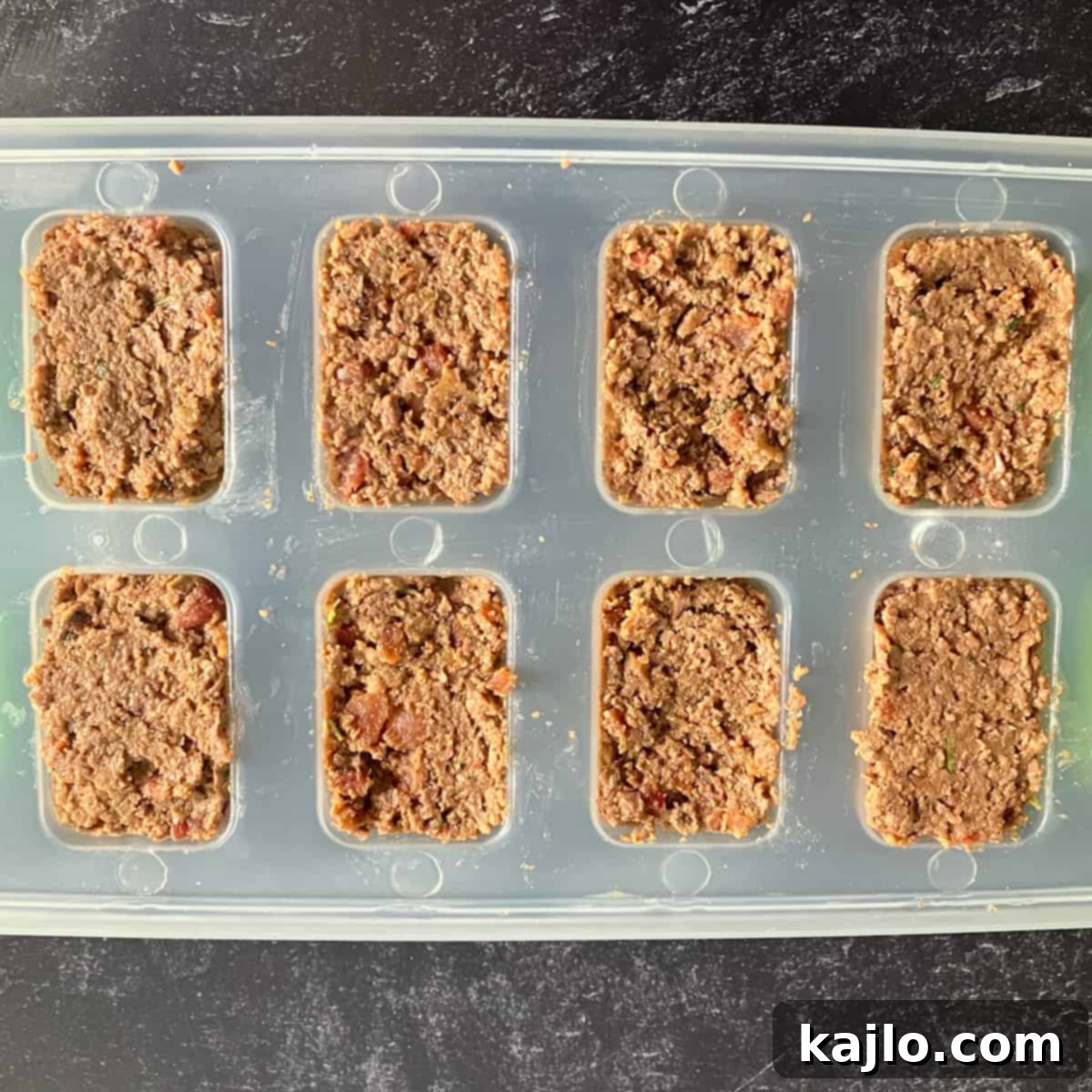
Both cooked and fresh raw pork liver can be safely stored in the refrigerator for up to 3-4 days when kept in an airtight container. Always prioritize food safety guidelines to ensure your culinary creations are not only delicious but also safe to consume.
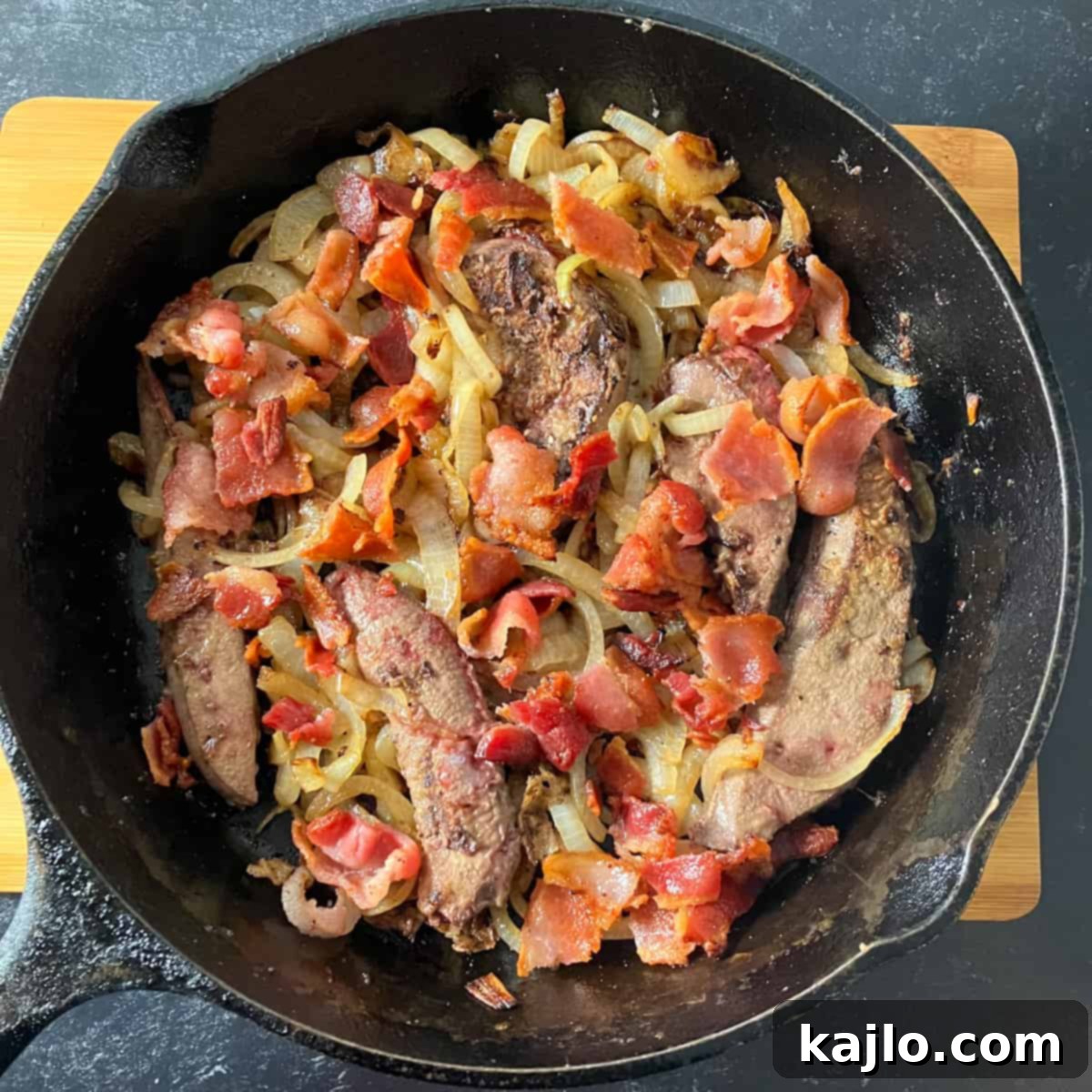
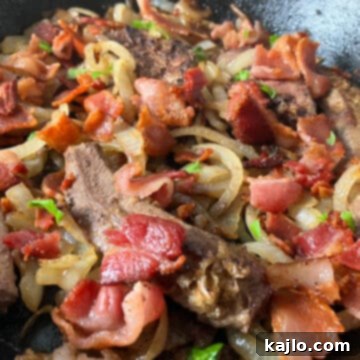
Pork Liver Recipe (Pig Liver Recipes)
By Summer Yule
Learn how to prepare pork liver with two delightful recipes: pan-fried pork liver and onions, and a creamy pig liver pâté. Both are easy to make and packed with nutrients!
15 mins
15 mins
Dinner
American
4
192 kcal
Ingredients
For Pork Liver and Onions:
- 8 ounces pork liver (227 grams)
- 2 tablespoons bacon fat
- 4 pieces thick-sliced bacon
- 2 medium onions (halved and sliced thinly)
- 1½ tablespoons flour
- Salt and pepper, to taste
- 1-2 cups buttermilk (for soaking)
For Pork Liver Pâté:
- 8 ounces pork liver (227 grams)
- 6 cloves garlic, minced
- ⅓ cup bacon fat
- 5 pieces thick-sliced bacon
- 1 medium onion, chopped
- 3 sprigs fresh parsley
- 2 sprigs fresh basil
- ¼ cup red wine
- Pinch of salt
- 1-2 cups buttermilk (for soaking)
Instructions
To Make Pork Liver and Onions:
- Remove the membrane from the liver and slice into ⅛-¼ inch pieces. Place in a medium bowl and cover with buttermilk. Soak for 2 hours in the refrigerator. After soaking, pat dry with paper towels.
- Cook bacon in a large skillet over medium heat until crispy. Set aside, crumble when cool. Leave bacon grease in the pan.
- Cook two thinly sliced onions in the bacon fat until done. Remove onions, leaving 2 tablespoons bacon fat in the skillet.
- Dredge liver slices in flour. Cook in the hot skillet 1-3 minutes per side until 145°F (63°C) internal temp. Season with salt and pepper.
- Once liver is cooked, add onions and bacon back to the pan and serve immediately.
To Make Pork Liver Pâté:
- Remove the membrane from the liver and chop into pieces. Place in a medium bowl and cover with buttermilk. Soak for 2 hours in the refrigerator. After soaking, pat dry with paper towels.
- Cook bacon in a cast iron skillet over medium heat. Set aside, crumble when cool. Leave ⅓ cup bacon grease in the pan.
- Cook chopped onion in bacon fat for 5 minutes to soften. Add liver and garlic, cook 5-10 minutes more.
- Add parsley, basil, wine, and salt. Turn skillet to low, cover, and cook for about 5 minutes.
- Allow mixture to cool slightly. Place in a food processor with cooked bacon and pulse until smooth.
- Serve the pâté on crusty crostini or with crackers. (Recipe closely adapted from Weston Price.)
Expert Tips from Dietitian Summer Yule
This is a level 1 recipe (may help support fat loss). Is pork liver healthy? Is eating pork liver good for you? The liver of a pig is an extremely nutrient-dense food, kind of like nature’s multivitamin. In terms of general nutrition, I would consider pork liver to be healthy.
Like a multivitamin though, you want to be sure not to overdo it. A little pork liver is nutritious, a lot is getting too much of a good thing.
It makes sense if you think about how humans had to eat before grocery stores. If a pig was killed, there was a lot of muscle meat to go around, and only a small amount of liver per person. Enjoy this powerfully nutrient-dense food as it was meant to be enjoyed—in small portions.
Is there a downside to eating liver?
Yes, the main downside to eating liver is that it’s so high in vitamin A it’s easy to overconsume this fat-soluble vitamin. Make sure to keep the portions of liver small, particularly for pregnant and breastfeeding women, as well as children.
Nutrition information provided is for one serving of pork liver and onions. The pork liver pâté is 133 calories for 1/6 of the recipe.
Nutrition Info Disclaimer
All recipes on this website may or may not be appropriate for you, depending on your medical needs and personal preferences. Consult with a registered dietitian or your physician if you need help determining the dietary pattern that may be best for you.
The nutrition information is an estimate provided as a courtesy. It will differ depending on the specific brands and ingredients that you use. Calorie information on food labels may be inaccurate, so please don’t sweat the numbers too much.
“To taste” means to your preferences, which may have to be visual to follow food safety rules. Please don’t eat undercooked food.
Nutrition Information (Per Serving of Pork Liver and Onions)
Carbohydrates: 9.9 g
Protein: 21.2 g
Fat: 6.7 g
Saturated Fat: 2.3 g
Fiber: 1.3 g
Vitamin A: 204 % DV
Vitamin C: 22.3 % DV
Calcium: 0.6 % DV
Iron: 57.2 % DV
Keywords
liver of pig, liver of pigs, pig liver, pig liver recipe, pig liver recipes, pigs liver, pork liver, pork liver recipe, pork liver recipes
Frequently Asked Questions About Pork Liver
How to Clean Pork Liver?
If your butcher has not already done so, you may need to remove the thin, translucent outer membrane from the liver. This can be peeled away with your fingers or a small knife. The USDA advises against washing raw meat, including liver, before cooking to prevent the spread of bacteria. Instead, the popular method of soaking the liver in milk or buttermilk (as described in our recipes) effectively helps to minimize any bitter or metallic taste, enhancing its flavor profile.
What Does Pig Liver Taste Like?
Pig liver possesses a distinct flavor profile that is quite similar to liverwurst, a sausage product often made with pork liver. It’s generally richer and slightly sweeter than beef liver, with a less intense “gamey” taste, making it more appealing to some palates. The flavor can vary depending on the preparation method; pâté will offer a milder, creamier experience, while pan-frying might bring out more of its natural robust notes.
Which Animal Has the Best Tasting Liver?
The quest for the “best-tasting” liver is entirely subjective and varies from person to person. It’s encouraged to experiment with different types to find your personal favorite! Many connoisseurs consider cod liver and pork liver to be among the tastiest, often praised for their relatively mild and delicate flavors. Chicken liver is also a popular choice, offering a tender texture and a generally well-accepted taste. Beef liver, while highly nutritious, can have a more pronounced, stronger flavor that some find too intense. Ultimately, your preference will dictate which liver delights your taste buds the most.
Is It Safe to Eat Cooked Pork Liver?
Absolutely, cooked pork liver is safe and nutritious to consume when prepared properly. It is not toxic. To ensure food safety, pork liver should always be cooked to a minimum safe internal temperature of 145°F (63°C). Using a meat thermometer is the most reliable way to verify it has reached the correct temperature, ensuring both safety and optimal texture.
How Often Should I Eat Pork Liver?
Due to its exceptionally high vitamin A content, it’s important to consume pork liver in moderation to avoid potentially toxic levels of this fat-soluble vitamin. For most healthy adults, enjoying 1-2 ounces of pork liver once per week is generally considered a safe and beneficial intake. This allows you to reap its extensive nutritional benefits without risking overconsumption of vitamin A. Always consult with a healthcare professional for personalized dietary advice, especially if you have underlying health conditions or are pregnant.
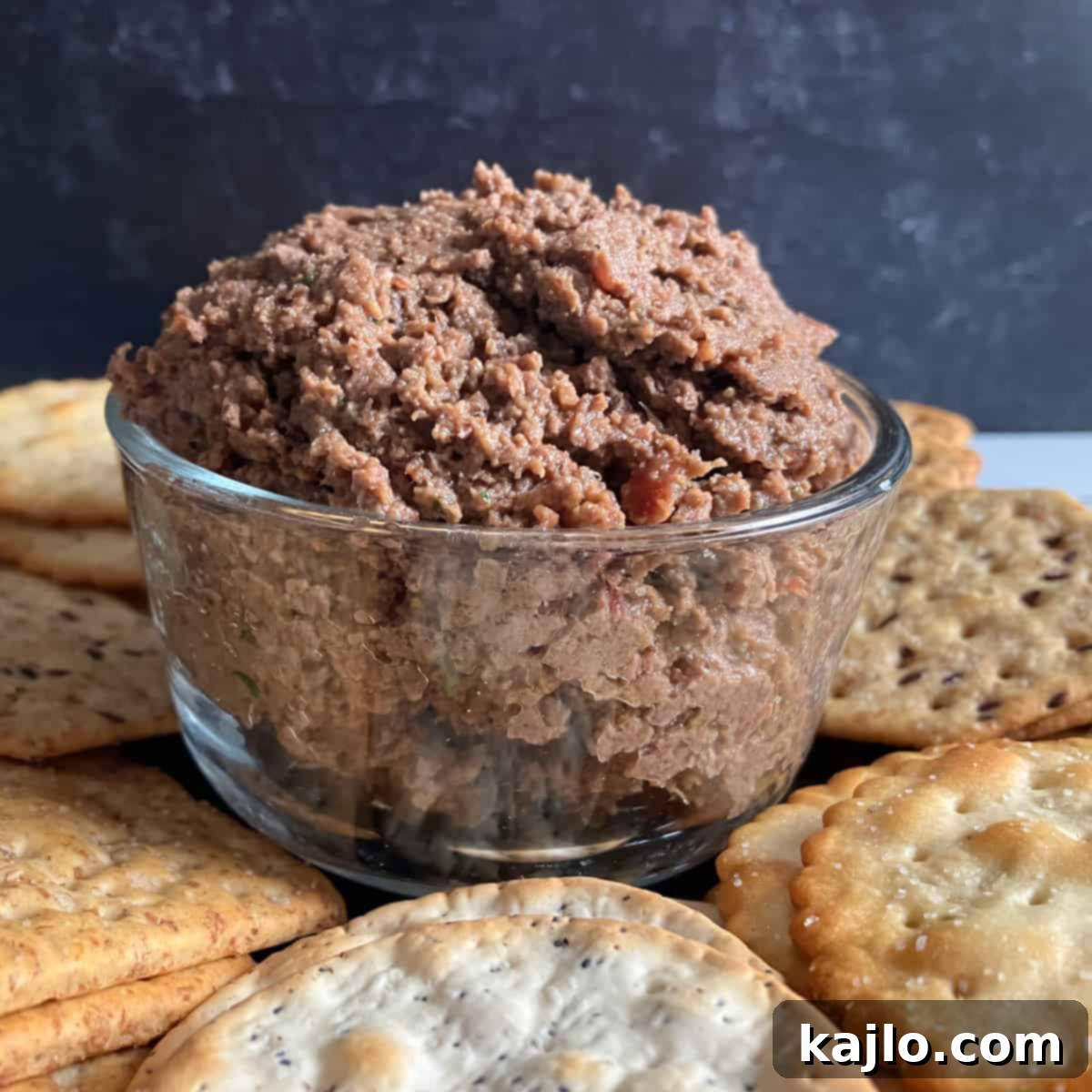
Explore More Organ Meat Recipes
If you’ve enjoyed your journey into cooking pork liver, consider expanding your culinary horizons with other nutrient-dense organ meats. Here are some more exciting recipes to try:
- Cod Liver Pâté: A delicate and nutritious spread.
- Beef Kidney: Rich in flavor and often prepared in stews.
- Lamb Hearts: Tender and lean, excellent grilled or sautéed.
- Beef Hearts: A robust and economical cut, great for grilling or braising.
- Chicken Hearts: Small, tender, and quick to cook, perfect for skewers or stir-fries.
Join our community! Subscribe for all of the latest and greatest recipes, and follow me on Facebook, Pinterest, Instagram, and YouTube!
